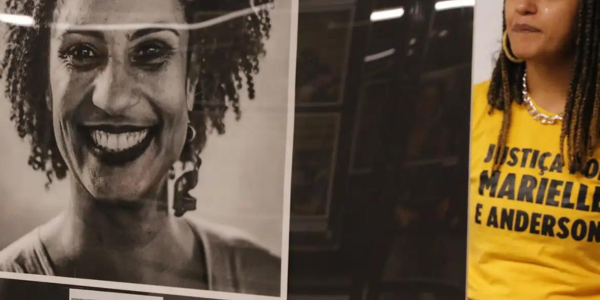A Copa do Mundo de 2014 tornou-se uma cortina de fumaça para o Brasil – uma distopia violenta exacerbada pela convivência de uma grande economia com desigualdades sociais, definindo esse país de 200 milhões de pessoas. Leia o artigo do profº Christhopher Gaffney publicado no Los Angeles Review of Books sobre o Mundial FIFA 2014 e os Jogos Olímpicos de 2016.
Partes globais, Galácticos Ressaca: Dystopia Mega Evento do Brasil
Por Christopher Gaffney
FOR MOST COUNTRIES, playing in four semi-finals of the last six World Cups would be considered a major accomplishment. But not for Brazil. At least since the 1938 World Cup, football has become the defining characteristic of the country, and since the 1970s, there has always been an expectation that Brazil will win the Cup, that losses are mere detours on a predestined path to glory. This belief had become so powerful as to be evangelical in its certainty — abandon all doubt, the salvation is coming before 90 minutes have passed. God, Zico, Socrates, Romário, Rivaldo, Ronaldo, Kaká, and Neymar will provide.
In the 2014 World Cup semi-finals, however, the visiting German national team didn’t only defeat Brazil 7-1. They embarrassed, humiliated, and toyed with the country of football on their own very expensive turf. Brazilians are still having trouble processing what happened. Just as the colossal failure to win the 1950 World Cup still haunts the national consciousness, the historic 7-1 drubbing by the Germans will shape the Brazilian football narrative for the foreseeable future.
Most of the post-World Cup media coverage favored this narrative, the opposite of the storyline leading up to the Cup — one of Brazilian favoritism on the field and impending disaster off. Before, Brazil´s seleção had the support of Vegas oddsmakers while the media clamored about the lack of preparation, the threat of social upheaval, and the decelerating economy. Naysayers doubted that the infrastructure of a country with such obvious deficiencies would be capable of hosting such a large event. And yet, as Brazil mourned its football team in Belo Horizonte’s Mineirão stadium, the World Cup itself was heralded as a success.
Incredibly, everything went according to plan. The stadiums were ready on time. The airports functioned well. Though expensive, there were enough hotels. Only one major piece of infrastructure collapsed, killing two people and injuring dozens — but no one blinked. The football was entertaining, the parties pulsating. The systematic violence used against protesters was brushed off as a necessary measure against radical student groups and anarchists. The police didn’t commit mass murders, few tourists disappeared, and Brazil came out on the other side of the World Cup with its reputation intact. The pessimists were either shunted aside, swept up in the euphoria, or never interviewed again. The smug satisfaction of FIFA and their Brazilian partners in government and industry bubbled over in their champagne glasses. After years of haranguing Brazil for their apparent disorganization, FIFA president Joseph Blatter gave Brazil a 9.25 out of 10, calling the tournament “very, very special.”
Though hyperbolic and facile, this is the narrative that seems to have won the day. Now that the dust has settled and Brazilians try t digest seven German goals, it is important to understand how Brazil managed this outcome and what has changed, because the Olympics are next.
¤
In 2007, Brazil’s former Minister of Sport Orlando Silva declared that not one penny of public money would be spent on the 12 World Cup stadiums. The logic was clear: stadiums are great investments, so the private sector will take them on. Yet the private sector was under no obligation to deliver FIFA-standard stadiums; the government was. The Brazilian government’s transparency sites indicate a public layout of more than 4 billion dollars in stadiums, the majority of which have been handed over to private consortiums. According to the Danish NGO Play the Game, the Brazilian World Cup stadiums are among the most expensive ever built and have become sites of social exclusion. In any country, stadiums reproduce and reinforce the existing socio-economic and cultural structure. In Brazil, these new stadiums have consolidated the privileges of the elite at the expense of everyone else.
One of the government’s justifications for the 10 billion dollar outlay on the World Cup was that Brazil was not investing in the tournament, but in the future of Brazilian cities. The investments included airport upgrades, communication lines, security, port renovations, hotels, tourist infrastructure, and urban mobility projects.
The majority of these projects, however, either attended to the demands of the Brazilian elite or reinforced the dominant paradigms of urban mobility. The multi-billion dollar investments in airports were long overdue, but will not stitch together more effectively Brazil’s urban archipelago. The main beneficiaries will be business travelers between Brazil´s major cities. Meanwhile, it is still not possible to travel between major cities by rail, and Brazil´s woeful road system was condemned by the World Health Organization for racking up more than 50,000 deaths a year. The government’s urban solution is more Bus Rapid Transit lines, which are cheaper than metro and light rail, but notoriously damaging to the urban fabric. BRTs mean more buses and more cars, less space for bicycles and pedestrians, and a massive subsidy for civil construction firms and automobile manufacturers.
After years without significant investment, no one questioned the utility of the infrastructure projects themselves. Meanwhile, the usual processes of long-term urban planning were discarded in order to throw pet projects into the Responsibility Matrix that every host city signs with FIFA. To achieve the short-term goals of the World Cup, host cities were given an exemption to Brazil’s federal Law of Fiscal Responsibility. This exemption allowed for deficit spending and the emergency financing of over-priced infrastructure. Cheap loans? Throw another project in. Tight deadline? Increase the cost, and do away with environmental impact studies, due process, and human rights. According to the Popular Committees of the World Cup, tens of thousands of families were forcibly and illegally removed from their homes.
Given all of this, the expectations of riots leading up to the World Cup were not far-fetched. The country had been in upheaval since before the Confederations’ Cup in 2013, with the violent repression of strikes and protests dominating the headlines. The national mood was sour. Brazilians forewent the long-standing traditions of painting streets, and the refrain “Imagina na Copa” (Imagine [how bad it will be] during the Cup) dominated everyday speech. Yet now the narrative of the World Cup has been spun in the positive, begging the question: how is a country that is so apparently dysfunctional capable of pulling off a mega event to such widespread acclaim?
Much of it was accomplished by force. The Instituto Humanitas Unisinos identifies the Rio de Janeiro Military Police as the force that most kills civilians in the world. The national army occupied the streets of Rio in the months before the World Cup, armed to the teeth and given a mandate to crush protests. According to Brazil’s 2012 strategic plan for World Cup security, the federal government planned to spend a billion dollars on public security, and the states and cities contributed much more. The threat of police violence kept most middle-class protesters at home. Israeli drones patrolled the skies, the FBI and CIA trained Rio’s police in counterinsurgency tactics, and new technologies of surveillance remain to keep a wary eye on the population. This kind of military operation hasn’t been seen in Brazil since the military dictatorship, but repeats itself with every major event. Currently the Brazilian Senate is debating whether public protests will be considered acts of terrorism. Just after the Cup, the president signed a law allowing Municipal Guards to carry guns. This is the same police force tasked with eliminating informal street vendors, taking drug users off the streets, and handing out parking tickets.
Another reason for the Cup’s apparent success is that anything is possible when 200 million people stop what they normally do. Brazilian productivity was disastrous during the event, and negative second quarter growth has ignited rumors of recession. People worked and traveled less. All public universities and municipal school systems were on vacation. Every time there was a match the host city declared a holiday, and the seven times the Brazilian national team played, the whole country took the day off. The streets were emptied of Brazilians and filled with tourists, which made it seem like the transportation systems were adequate, the security pervasive, and the party everlasting.
It also helped that Brazil and FIFA treated the press very, very well. Journalists had express service at airports and were taken around on special junkets to see the best Brazil has to offer. The working conditions at the new stadiums were good and the temporary wi-fi was fast. Most had never been to Brazil and had no point of reference while others forgot about old difficulties after a few caipirinhas. The anticipated story of massive protests didn’t materialize and even when there was a major disaster, no one wanted to spoil the mood, not once the stadium lights turned on and the ball started rolling.
It’s true that Brazil is an amazing place with fantastic people who know how to put on a spectacular party at the last minute. Most visitors had a great experience, enjoying the football, the sunshine, and the camaraderie. But the same cannot be said for the millions of Brazilians cleaning the toilets, working as stewards and security guards, recycling beer cans or being shaken down by the police. The 2014 World Cup became a smokescreen for Brazil’s violent dystopia even as it exacerbated the stark economic and social inequalities that define this country of 200 million.
Leia o artigo completo no site do Los Angeles Review of Books.
Publicado em Artigos Semanais | Última modificação em 09-10-2014 12:03:03









